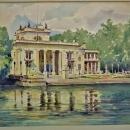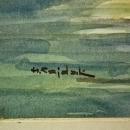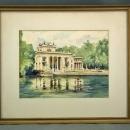Large Polish Watercolor Painting Łazienki Palace in Warsaw Poland by HENRYK SAJDAK







$1,100.00
Or Best OfferA semi-antique Polish large watercolor painting from around 1930-1940 by the well-known listed Polish artist HENRYK SAJDAK (1905-1995).
This is an exquisite watercolor painting meticulously crafted on paper that showcases a breathtaking view of the Łazienki Palace located on an island in Warsaw, Poland. The artist has skillfully captured the beauty of the Palace, its surroundings, and the sparkling water in the foreground. The painting is an exceptional example of the artist's talent and creativity and is signed by the artist in the lower left corner, adding to its authenticity and value.
Note that the painting has no glass, which is a common practice in watercolor paintings. The absence of glass allows for safer
shipping. This is because glass can easily break during transit and damage the artwork.
MEASUREMENTS:
Dimensions with frame: 64 cm x 54.5 cm (25.2 x 21.5 inches).
Dimensions without frame and mat: 41cm x 31 cm (16.4 x 12.2 inches).
CONDITION:
The painting is in very good condition, free of stain marks or damage. There have been no restorations whatsoever. It shows its age, with a cardboard mat (passe-partout) stained near the edges of the wooden frame. There is no glass.
Henryk Sajdak (1905-1995) - Krakow painter. Initially, he studied at the Academy of Fine Arts in Krakow and later continued his studies in Paris. He worked mainly in the watercolor technique. He painted urban landscapes (especially of Krakow), as well as landscapes of other cities and numerous Tatra mountain landscapes. He died at the age of ninety in 1995 and was buried at the Rakowicki Cemetery in Kraków.
Most of Henryk Sajdak's paintings on the art market were painted after WWII, mainly from the 1960s to 1990.
This watercolor is a rare example of his work painted before WWII.
PROVENANCE:
It was acquired from the estate sale of a private Canadian art collection, where it was displayed with other Polish paintings for several decades.
With a significant demand for Polish antiques and art, including paintings, many reproductions of Polish paintings have been seen on the international art market in recent years.
In many cases, these reproductions are very well painted by talented artists, and for inexperienced collectors, they look the same as authentic paintings. However, these reproductions do not have any historical or investment value.
The buyer will receive a certificate of authenticity issued by our company, Hundred & One Antiques.
NOTE: Today's Palace on the Isle dates back to the late seventeenth century. The Bathhouse was built at the behest of Prince Stanisław Herakliusz Lubomirski, one of the most influential politicians, writers, and philosophers of the time.
The Baroque Garden pavilion, designed by the Dutch architect Tylman van Gameren, was intended for rest, leisure, and contemplation. The interiors of the Bathhouse were stylized like a cave with a spring, symbolizing the Hippocrene, a fountain on Mount Helicon in ancient Greece, which was the source of poetic inspiration for the Muses.
In 1764, when looking for a place to build his summer residence, King Stanisław August purchased the Bathhouse together with the Ujazdowski estate. Thanks to two architects – the Italian-born Domenico Merlini and Johann Christian Kammsetzer, born in Dresden – the King transformed the Baroque Bathhouse pavilion into the neoclassical Palace on the Isle. Modeled on Italian architectural solutions, such as the Villa Borghese, Villa Albani, Villa Medici, and Villa Ludovisi, it was intended to symbolize the dream of an ideal, modern, and sovereign state.
Stanisław August transformed the Palace on the Isle into a villa museum where he displayed the most valuable paintings from his collection of 2,289 works of art by some of the most distinguished European artists of the seventeenth and eighteenth centuries. Dutch artists were the best represented; the finest paintings among them were those executed by Rembrandt van Rijn. Girl in a Picture Frame and Scholar at His Writing Table were bought from the King's heirs in 1815 for the Lanckoroński collection, and thanks to the donation from Karolina Lanckorońska made in 1994, they now hang in the Royal Castle in Warsaw.
Today, 140 works of art from the King's collection are on display in the Palace on the Isle and are exhibited in line with eighteenth-century principles. The most important works are Anton R. Mengs' Portrait of Sir Charles Hanbury Williams – English ambassador to Russia and friend of King Stanisław August – Jacob Jordaens the Elder's Satyr Playing a Flute, Jan Victors' Jacob and Esau, and Angelica Kauffmann's Portrait of Princess Giuliana Pubblicola Santacroce.
For Stanisław August, art was not just an aesthetic decoration of his residence. Paintings, sculptures, and architecture were part of a programme that encompassed political, social, and economic matters and whose goal was to repair the Republic and foster national identity. Fine arts were to "shape the nation's spiritual culture" and contribute to its revival.
Paintings, sculptures, and prints – combined with architecture – formed a complete work, which, according to the King's concept conceived in 1792, was to become the first modern public museum.






